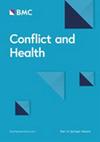Prevalence, comorbidities, and factors associated with prolonged grief disorder, posttraumatic stress disorder and complex posttraumatic stress disorder in refugees: a systematic review
IF 3.4
2区 医学
Q2 PUBLIC, ENVIRONMENTAL & OCCUPATIONAL HEALTH
引用次数: 0
Abstract
The number of refugees worldwide is at an all-time high with many being exposed to potentially traumatic events and the loss of loved ones. The 11th revision of the International Statistical Classification of Diseases and Related Health Problems now includes prolonged grief disorder and complex posttraumatic stress disorder and revised criteria for posttraumatic stress disorder. An overview of these stress-related disorders among people who have become refugees is therefore needed. Consequently, we conducted a systematic review to determine prevalence rates, comorbidities, and associated factors for each of the disorders. We systematically searched PubMed, Web of Science, and PsycArticles to identify studies that reported prevalence rates, predictors or associated factors, and/or comorbid mental disorders for either (1) prolonged grief disorder, (2) posttraumatic stress disorder, or (3) complex posttraumatic stress disorder among refugees. The selection process followed the PRISMA guidelines. A total of 36 studies met the inclusion criteria. Most of the studies were of high quality. There was substantial variation in prevalence rates by disorder, with prolonged grief ranging from 6 to 54%, posttraumatic stress disorder ranging from 0.4 to 80%, and complex posttraumatic stress disorder ranging from 3 to 74.6%. Pooled prevalence for posttraumatic stress disorder was estimated at 29.8% in treatment seeking samples and 9.92% in population samples. For complex posttraumatic stress disorder, it was estimated at 57.4% in treatment seeking samples and 7.8% in population samples. Posttraumatic stress disorder was among the most frequent comorbidities for prolonged grief disorder while depressive symptoms were the most frequently occurring co-morbidity across all three disorders. Sociodemographic variables, trauma exposure, and loss characteristics were associated with higher symptom severity. Postmigration living difficulties played an important role in prolonged grief and complex posttraumatic stress disorder. The review revealed substantial differences in prevalence rates between the three studied disorders but underscored a very high prevalence of ICD-11 stress-related disorders among refugees. The identified associated factors point to subgroups that may be particularly at risk and establishes a foundational basis for targeted interventions and potential policy changes. Future research should incorporate longitudinal investigations and emphasize culturally sensitive assessments.难民中长期悲伤障碍、创伤后应激障碍和复杂创伤后应激障碍的患病率、合并症和相关因素:系统性审查
全球难民人数达到历史最高水平,其中许多人可能遭受创伤事件和失去亲人。国际疾病和相关健康问题统计分类》第 11 次修订版现已列入长期悲伤障碍和复杂创伤后应激障碍,并修订了创伤后应激障碍的标准。因此,我们需要对难民中出现的这些应激障碍进行概述。因此,我们进行了一项系统性综述,以确定每种障碍的患病率、合并症和相关因素。我们对PubMed、Web of Science和PsycArticles进行了系统性检索,以确定报告了难民中(1)长期悲伤障碍、(2)创伤后应激障碍或(3)复杂创伤后应激障碍的患病率、预测因素或相关因素和/或合并精神障碍的研究。筛选过程遵循 PRISMA 指南。共有 36 项研究符合纳入标准。大部分研究的质量较高。不同病症的患病率差异很大,长期悲伤的患病率从6%到54%不等,创伤后应激障碍的患病率从0.4%到80%不等,复杂创伤后应激障碍的患病率从3%到74.6%不等。据估计,在寻求治疗的样本中,创伤后应激障碍的合计患病率为 29.8%,在人口样本中为 9.92%。就复杂性创伤后应激障碍而言,估计在寻求治疗的样本中发病率为 57.4%,在人口样本中发病率为 7.8%。创伤后应激障碍是长期悲伤障碍最常见的合并症之一,而抑郁症状则是所有三种障碍中最常见的合并症。社会人口学变量、创伤暴露和损失特征与较高的症状严重性相关。移民后的生活困难在长期悲痛和复杂创伤后应激障碍中起着重要作用。研究显示,所研究的三种障碍的患病率存在很大差异,但强调了难民中ICD-11压力相关障碍的患病率非常高。已确定的相关因素指出了可能面临特别风险的亚群体,并为有针对性的干预措施和潜在的政策变化奠定了基础。今后的研究应包括纵向调查,并强调文化敏感性评估。
本文章由计算机程序翻译,如有差异,请以英文原文为准。
求助全文
约1分钟内获得全文
求助全文
来源期刊

Conflict and Health
Medicine-Public Health, Environmental and Occupational Health
CiteScore
6.10
自引率
5.60%
发文量
57
审稿时长
18 weeks
期刊介绍:
Conflict and Health is a highly-accessed, open access journal providing a global platform to disseminate insightful and impactful studies documenting the public health impacts and responses related to armed conflict, humanitarian crises, and forced migration.
 求助内容:
求助内容: 应助结果提醒方式:
应助结果提醒方式:


